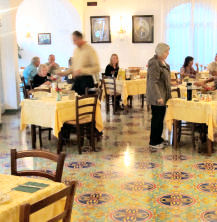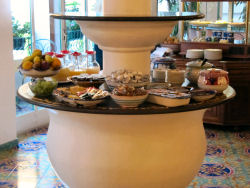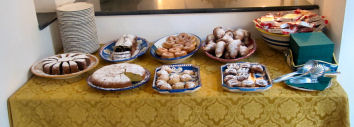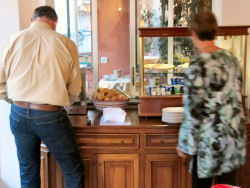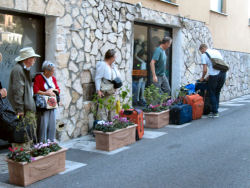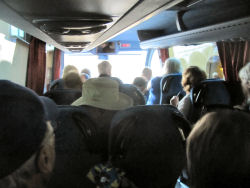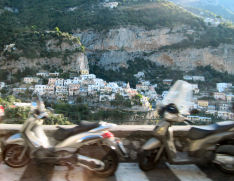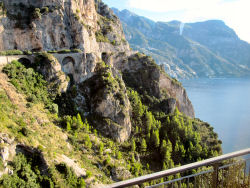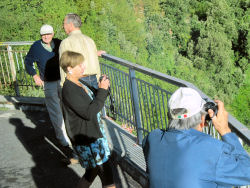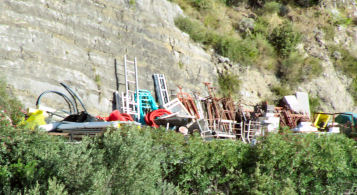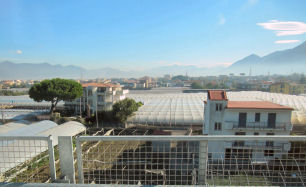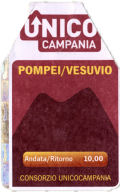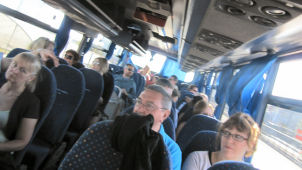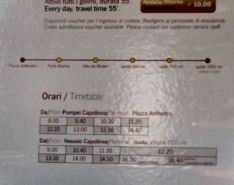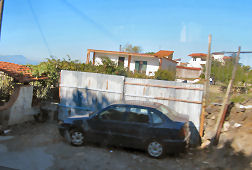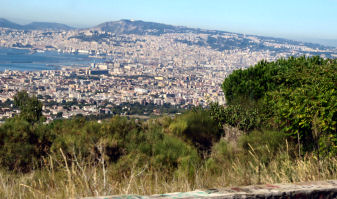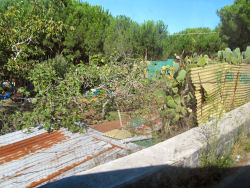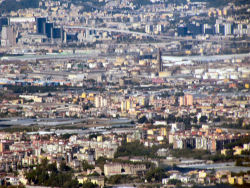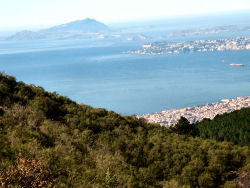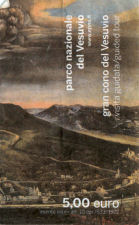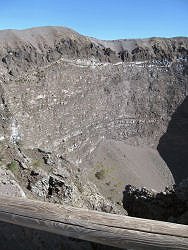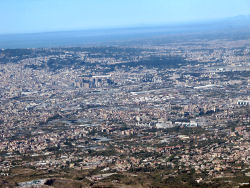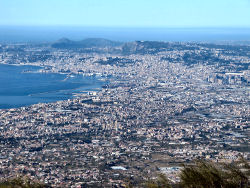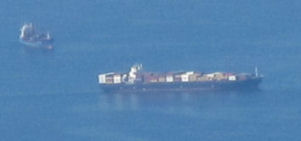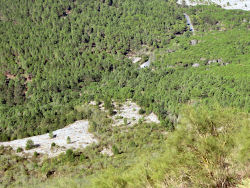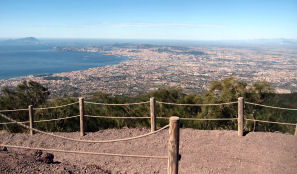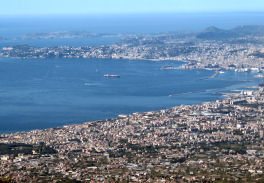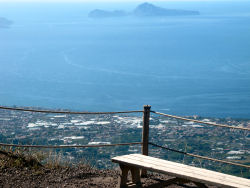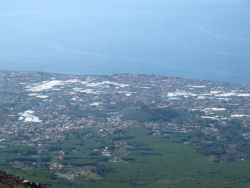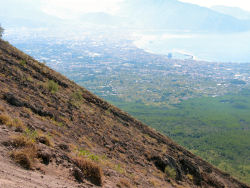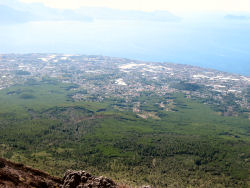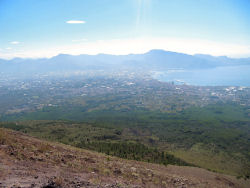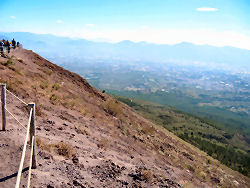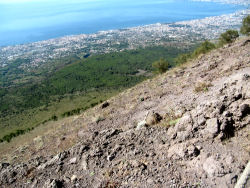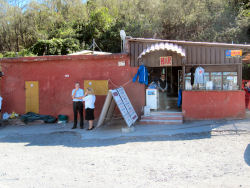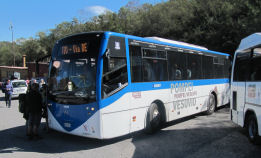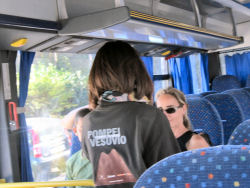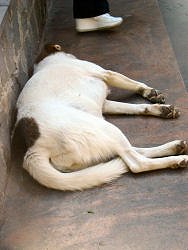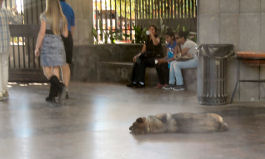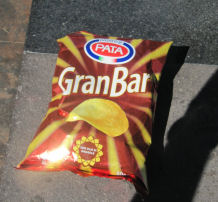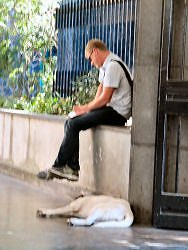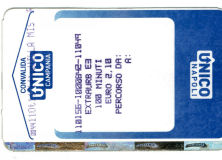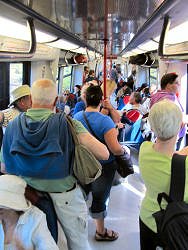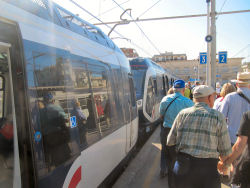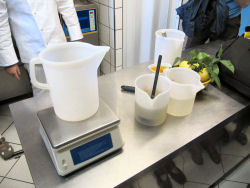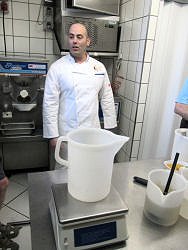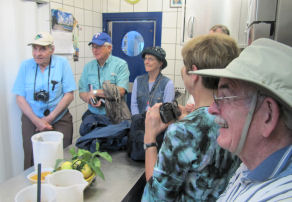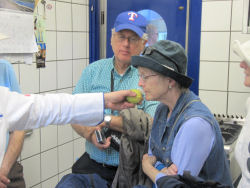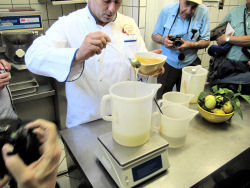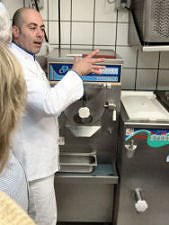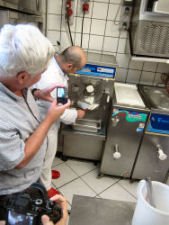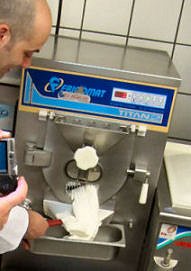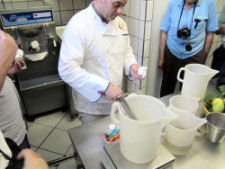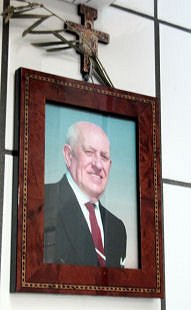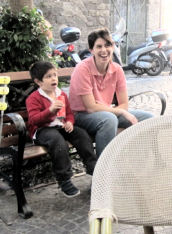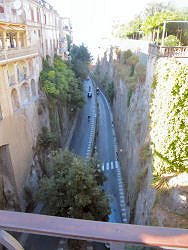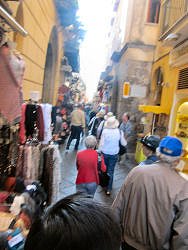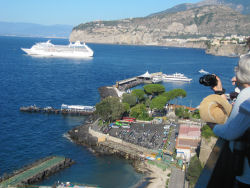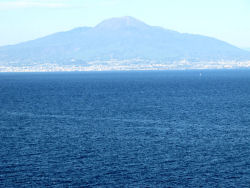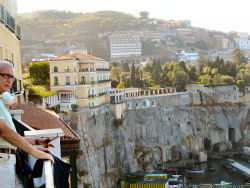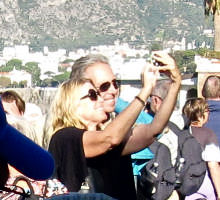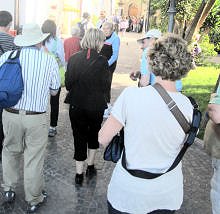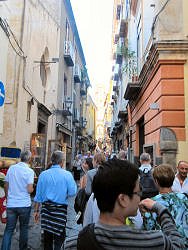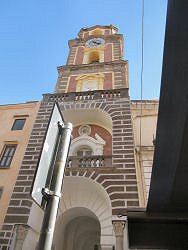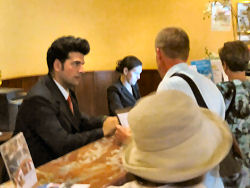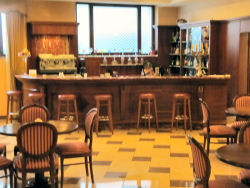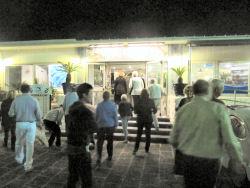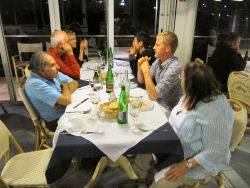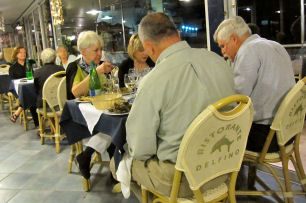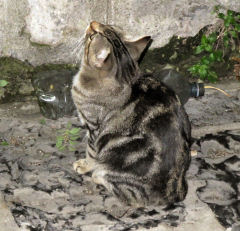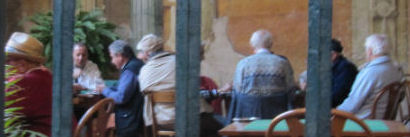Our plan for this day was a little complicated. After breakfast we would again board the hotel’s vans, which would transport us to the lot in which Giulio had parked his bus. Our final bus ride with Giulio would take us from Positano to Pompeii. The group was then scheduled to visit the huge excavation site of Pompeii, but Sue and I had different plans. We had already toured Pompeii eight years ago – with the same guide, no less – and neither of us was interested in doing it again. Sue intended to stay on the bus and continue on to Sorrento with Giulio and all of our luggage. I planned to take the public bus from Pompeii to Vesuvius, climb the mountain’s peak, and return to Pompeii by bus in time to meet up with the group. The plan at that point called for all of us, except Sue, to take the Circumvesuviana train from Pompeii to Sorrento.
Our first stop in Sorrento was to be at a gelateria for a demonstration of gelato-making. Sue hoped to link back up with us at the gelateria. If she could not make that connection, she would meet us at the hotel. I went down to the first floor before breakfast to use the Internet. The big room was not open yet, but I could see activity inside. I sat on a bench outside of the room and fired up my laptop. Almost immediately the man who was in charge of breakfast opened the door and invited me to sit in the lounge. I did so, and I discovered nothing of note in my e-mails. I checked the baseball scores and discovered that Texas and St. Louis had won their first games. At breakfast Sue and I sat with Steve and Edie. We had a nice repast and a nice conversation. I was definitely warming up to almost everyone in the tour group. I remembered that I had had similar experiences on previous tours. Without a doubt, some people grow on you.I went up to the room and packed, but I could not locate one of my red rubber earplugs. If I needed them, Is still had with me the pair that ETBD had provided. I was proud that I had not lost anything else since I had left my mouse on the bench in Viterbo. If this turned out to be my biggest problem, I would have had a successful trip. I decided that I did not want to climb a mountain with my computer and my bag of broken cookies in my backpack, so I shoved both of them into my suitcase. I was able to get it closed, but not without cramming some clothes into side compartments. After breakfast I paid the clerk at the hotel €2 for the bottle of water that Sue had consumed. The same product could be had for half of that on the bus. She must have needed the bottle for some reason; tap water in Italy is safe and, at least to my palate, tasty. The group lingered around outside the Albergo Savoia for a few minutes waiting for the hotel’s two vans. The street was one-way, so they had to go all the way around to pick us up. When they showed up, we hurriedly clambered aboard so as not to back up the traffic any longer than necessary. Because of the circuitous route, the trip to the spot where we were to meet Giulio took a little longer than the first trip on the vans. Giulio’s bus was not there yet, so we had a couple of minutes to take advantage of the morning light to photograph Positano from above.On the bus Rainer donned his geologist’s hat. He told us that the Mediterranean was about ten thousand feet deep. Surprisingly, algae had been found at a depth of one thousand feet. Scientists had conjectured that the sea may have been cut off from the ocean at one time and actually evaporated.
Sorrento sits on the edge of a plain that separates the Gulf of Naples and the Amalfi Coast. This would become strikingly clear to me later that day.
In 79 AD Vesuvius erupted and covered Pompeii with several feet of ash. When the city was rediscovered in 1749, many pockets of air had been found in the ash. One hundred years later Giuseppe Fiorelli perfected the technique of inserting plaster into the spaces. When he extracted the forms, he determined that they were people and animals that had been killed in the eruption. Time would be provided for lunch after the tour of Pompeii. The group was expected to assemble at the entrance to the archeological site at 1:55. The train for Sorrento was scheduled to depart at 2:05. When the group arrived in Sorrento, Rainer would lead us to the gelateria for the demonstration. From there we would walk to the hotel.Wednesday was to be a free day. Tuesday evening would be free as well, although at 6:30 there would be a Happy Hour in the lobby of the hotel.
Sorrento boasted two poorly-named marinas. The primary one was called Marina Piccola, the departure point for the large boats bound for Capri and the other islands. The hotel was closer to Marina Grande, which was the home of several good seafood restaurants.Rainer more or less expected nearly everyone to use the free day for an excursion by boat to Capri (accent on the first syllable), which had been the site of a meeting between American generals and Churchill in 1943. All of the large boats in Capri arrived at its main marina, which was appropriately called Marina Grande. There was a lot to do on the island, and Rainer emphasized the importance of having a plan before one arrived. He recommended that everyone who intended to visit the island spend some time reading the guide book and planning.
Sue and I had taken the boat from Sorrento out to Capri in 2003. We had enjoyed the experience, and we were eager to return. I had had a marvelous adventure taking the chairlift to the top of Mount Solaro. Sue had enjoyed exploring Anacapri, and she had found an interesting store that sold miniatures. They had even constructed a miniature of the entire island, and they displayed it in the middle of a swimming pool. We had also enjoyed a nice lunch of pizza and a beer. Our plan was basically to come as close as we could to repeating that experience.As the bus passed near the town of Castellammare di Stabia, which lies between Naples and Sorrento, I could see numerous apartments, hot houses, and gardens. It was more modern than I expected. The area surrounding Naples had such a bad reputation that I must have been anticipating something akin to nineteenth-century Calcutta.
We said arrivederci to Giulio as he let us off at Piazza Esedra in Pompeii, and we walked together up to the excavation site. The first order of business was a potty break. At that point I asked Rainer for some help in locating the bus stop for Vesuvius. He informed me that it was back the way that we had just come, and he also told me that the hostel in Sorrento would be easy to find from the train station. One basically just went up Via Corso until one reached Via del Mare, the street that the hostel was on. The guide book had maps of both Pompeii and Sorrento, and they included the bus stop and the hostel. I walked back down to Piazza Esedra. Although the map in the guidebook accurately indicated the location of the bus stop, I had trouble finding it because the street labeled “Via Mass.” on the map was not marked with any kind of a sign that I could see and was much shorter than the map seemed to indicate. Furthermore, the text in the Vesuvius section said that the bus left from Piazza Esedra, which was inaccurate. The stop was, however, definitely close to the piazza. I had to ask directions from two locals before I found the tourist office at about 10:15. The office itself was poorly marked, and there was no indication whatever that the bus stopped there. The man inside informed me that the bus did indeed stop right outside of the office, and I should buy my ticket on the bus. After I had been waiting for the bus for about twenty-five minutes, a couple arrived at the tourist information office, went inside, exited with some brochures, and then hung around outside of the office. They were speaking a language that I did not recognize, so I did not consider engaging them in conversation. Buses of every description came and went through the short but wide one-way street. At 10:55 a bus finally stopped in front of the office. It was blue (and white), but it looked nothing like the description in the book. It did not have “Vesuviana Mobilità” anywhere on it. Instead it said “Unico Campania.” I did see a little sign with the word “Vesuvio” on it, so I boarded and asked the man in the first seat, “Per Vesuvio?” He said “Sì,” and I paid him €10 for the round-trip ticket. The couple that was also waiting outside the tourist office did not budge when I boarded the bus, so I deduced that they must have had other plans. The bus was almost full when I boarded, but I found an empty seat near the front. The other people on the bus seemed mostly to be speaking English with British accents. They must have gotten on at the Piazza Amfiteatro. The best thing about my seat was that it gave me a good view of the placard with the bus schedule. The return trips were scheduled to leave Vesuvius at 11:30, 12:20, 1:10, 2:00, 2:50, and 4:50. The guidebook said that the trip up the mountain required an hour and a half, and the return trip took an hour. If so, this bus would not arrive at the peak until 12:25. If I took the 1:10 bus back, and it departed on time, I would arrive back in Pompeii a little too late to catch the train, if the train was on time. This was extremely discouraging. It did not seem possible for me to make it back before the rest of the group left for Sorrento. Fortunately for me, the authors of the guidebook did not take into account the bus driver’s lead foot. The first part of the journey was on the highway. We ended up in the suburban town of Torre del Greco, which, if its rather elegant houses were at all representative, seemed to be quite nice. We saw a few modern statues along the road that served no discernible purpose. After it left Torre del Greco, the bus began to head up the mountain on narrow winding roads that passed through the woods by way of one switchback after another. The driver used his horn as much as his steering wheel. We reached the parking lot of the Osservatoio much sooner than I expected. It was only about 11:45. I began to hold out a little hope that I might be able to make it aboard the 12:20 returning bus if I really hustled.A woman wearing a jacket with “Unico Campania” on it boarded the bus and addressed us in English. She asked if everyone had a voucher. Everyone seemed to have one except for me. After we got off the bus I asked her about the voucher. She said that she could sell me a ticket for €7, which, according to her, was a euro less than the price at the biglietteria. I was a little dubious when the ticket that she gave me had a face value of only €5, but I had no time to argue.
I expected the weather to be quite chilly, if not downright cold, at the top of the mountain, but I was not really uncomfortable in my jacket even though the wind was quite strong. I did need to remove my Mystic Seaport baseball cap and stuff it in my pocket lest someone in Torre del Greco find it in the backyard.
I walked as fast as I could up to the ticket-taker. A few years ago I probably could have jogged all the way up to the rim and still have been able to catch my breath within a minute. My old carcass was not nearly in that kind of shape in 2011. Nevertheless, even though I was nearly the senior pedestrian on the long road up to the rim, no one passed me, and I zoomed around several dozen people.
The views from the top were nothing short of spectacular. There was a little haze, but one could still see all the way out to Ischia and Capri, which was more than twenty miles away. I took quite a few photos of the interior of the volcano, which was surprisingly deep, the Bay of Naples, and the Sorrento Plain. The congested city of Naples seemed disarmingly close. I know nothing about volcanology, but it seemed like absurdly wishful thinking to claim that Naples need not worry about an eruption. A lot of people were walking around the rim, and their average age must have been no more than thirty. I definitely felt like a senior citizen, but I did not find the activity all that strenuous. The footing was fine except for one or two places in which one had to climb rickety stone staircases, but even those only went up ten or fifteen feet. I wondered how many people fell every year. In most places the only thing separating the tourists from a precipitous drop was a strand or two of rope.I did not see any aged German tourists with their walking sticks, but there was one boisterous group of young guys from Bavaria dressed in lederhosen. They were sitting at a picnic table enjoying their lunch.
I hiked about halfway around the mountaintop. I started on the side facing Naples, and I proceeded counterclockwise until I had obtained a pretty good view of the Amalfi Coast. I could think of no way of determining whether the path went all the way around or deadended at some point. Since I did not notice a path in the other direction at the start of the trail, I was afraid to take a chance that continuing might cause me to miss that 12:20 bus. I was also starting to get hungry. My pace going back to the entrance was at least as frenetic as on the andata leg, and it got me to the area where the bus had dropped us off at about 12:15. I could see no sign of the bus or anyone waiting for it. I looked for the lady who had met the bus and sold me my ticket to the site, but I did not see her. I thought about going over to the bar and buying something to eat, but the only things about it that looked inviting were the empty chairs. On the other side of the parking lot were several stands selling souvenirs next to a hand-painted sign advertising a WC. I would only have patronized the latter if I had been extremely desperate.At about 12:30 I overheard a man talking to his young son in English about taking the bus back to Pompeii. This made me feel better. Five minutes later the bus came up the road, and its passengers disembarked forthwith. I was shocked to see the couple who had been waiting with me outside of the Tourist Information Office. My heavens! I had boarded the bus that went up to Vesuvius more than two hours earlier. Could they possibly have been sitting there the entire time?[1]
Rainer had told me that in previous years the group had driven up to Vesuvius, hiked to the rim, taken a quick look therein, turned around and hiked back to the bus, driven down to Pompeii, toured the grounds, and then caught the train to Sorrento. He said that the pace was exhausting, and the tour guides unanimously had recommended putting the kibosh on the excursion to Vesuvius. I could testify that by the time that I rejoined the group I was in no mood to spend an hour or two walking around Pompeii, and I was probably in a little better condition than the average Rick Steves tourist. The lady who met our bus materialized from nowhere to help the new busload of tourists. She also made sure that all of us who were boarding for the return trip had tickets. The bus driver really put the pedal to the metal, and he made it back to Pompeii by approximately 1:20. I was the only person aboard who disembarked at the Tourist Information Office. I hiked up to the excavation site and was very happy to see some familiar faces from our group. I had plenty of time to get some lunch, if I wanted it.I wandered among the fast food places just outside of the excavation site, but nothing caught my fancy. I did not feel like eating alone, and the few tour members whom I saw there were already seated at full tables. Instead, I just bought a pretty good-sized bag of potato chips, took them up to the entrance area, and ate them while seated on a stone wall. I washed down the chips with the water in my Coke bottle.
I spent a good deal of time watching and photographing the lazy dogs that, from all appearances, had died there. One of them flopped down near the spot that Rainer chose for making telephone calls on his iPhone. People from our group trickled into the entrance area. Everyone was talking about how Gaetano Manfredi, the tour guide, had reprimanded a group of German tourists whose presence had in some way offended him. I was not there, and there were several versions of the story, but the gist of it was that Gaetano reminded them that the Americans that he was guiding were responsible for Italy being a free country today. My buddy, Bob, came over to me and asked me where I had been. Evidently Rainer had verbally excused him from the first buddy-check without an explanation, and he wondered what I had been up to. I did not have a good yarn ready, and so I reluctantly told him the truth.At the appointed time the group trooped over to the nearby train station. Rainer bought the tickets and handed them out. He told us to convalidate them in the little orange machine and then advised us to spread out on the platform of track #1.According to Rainer, the Circumvesuviana had an undeserved reputation as a seedy and dangerous means of transportation. He said that the trains were not as bad as they looked. Everyone was therefore astonished when a brand new train with three cars appeared a fashionable fifteen minutes late.
The train was quite crowded. Almost all of the men had to stand through the entire forty-five minute trip to Sorrento. The stops were not announced, or at least I never heard any. The stations may have had their names displayed somewhere, but they were not visible from my vantage point at the front of the last car. I coveted in my heart a very comfortable-looking chair in the small cabin that was just behind me. I actually considered trying to open the door in order to park my keister on the chair, but my Midwestern respect for order restrained me. The ceiling of the car that we rode in was equipped with one of those little crawling electronic message boards. It presumably was supposed to show the name of the next station. Instead it just displayed “Metrostar Circumvesuviana” over and over and over. Fortunately, there was no missing our stop, Sorrento. It was the last one on the line.Rainer made sure that everyone was still with us before we began the short walk to Gelateria David for the gelato demonstration. At this point, frankly, I would have preferred a mattress demonstration.
There were no chairs in the kitchen, but I made sure that I had a counter to lean against. Giovanni told us that the company was founded in 1957 by his mother’s father, Augusto Davide. A photo of the patriarch was displayed in the back room. Originally he sold cheese, but he shortly thereafter made the switch to gelato.
Giovanni emphasized that he used only fresh ingredients, and he changed the flavors that he made every day based upon what was available. He told us that limoncello was invented in Sorrento and that Sorrento had the most fragrant lemons. Frank, of course, insisted that the lemons in Sicily were superior, and Giovanni diplomatically conceded that Sicily produced very good lemons. Giovanni gave us the recipe for limoncello, but it was too cramped for me to take notes, and, to be honest, I was too lazy. Sorry. The ladies seemed to be paying close attention to all of the recipes. Maybe one of them can supply the details. Frank asked a few questions, or more precisely he supplied a bit of commentary at salient intervals. I recalled little of this other than that he mentioned the “tall drink of water,” Alfeo, who had been his tour guide on two different occasions. Alfeo also evidently praised the superiority of Sicilian cuisine. Alfeo’s primary claim to fame was that he was a second cousin to Joe DiMaggio.[2]Giovanni explained what all of his very expensive machines did. One was used to purify the fresh milk by bringing it to a very high temperature and then rapidly cooling it. The main one mixed the ingredients and blew air (which Giovanni pronounced as “hair”) into it.
The best part was when Giovanni showed us how to make a lemon sorbet. The ingredients were fresh lemon juice, three different kinds of sweetener – white sugar, glucose, and corn syrup – and water. He disclosed the proportions, but I neglected to record them. He mixed them together very carefully, stirred them up a little, and then put them in the machine. A minute or two later out came the very creamy sorbet. We each got to sample a few mouthfuls in a paper cup. Everyone said that without question it was the best that they had ever tasted.
Afterwards we exchanged places with the other group. I could not find pistacchio in the case, so I selected strasciatelli and almonds as my two flavors. I am not a gourmet when it comes to ice cream, but I thought that the gelato was quite good.
It was a shame that Sue was not able to attend. She would definitely have enjoyed the entire event. She loves to learn how to make yummy comestibles, and she enjoys nothing more than eating gelato. I was somewhat surprised that she had been unable to engineer some way of joining us.
The group then returned to Via Corso via a different narrow road the terminus of which was the clock tower. Rainer pointed out the old-timers playing cards in the men’s club[3] as we passed them by. We also walked past the English Inn, which evidently took great pride in its English breakfasts and its fish and chips. English breakfasts are fine, but IMHO anyone who would order fish and chips when fresh Italian food was available needed to have his taste buds examined. Across from the English Inn was a laundromat. Its presence should have reminded me about the exigency of keeping my own clothes clean, but, as often happened, I was oblivious.
We strolled down Via Corso until just past the hospital. Then we descended the stairs and found ourselves on the narrow concourse known as Via del Mare. The Ulisse Deluxe Hostel was a little ways down the road on the left. I realized that I would never have been able to figure out to take the staircase down to Via del Mare. Both streets were on the map of Sorrento in Rick Steves’ book, but there was no indication that one street was forty feet higher than the other when they intersected. Thank Oprah that I caught the train and did not have to find the hostel on my own. The hotel was surprisingly beautiful on the inside with a stunningly spacious and elegant lobby. You certainly would not expect this from something called a hostel. Rainer checked us in. Working the desk at the time was a guy with a gravity-defying hairdo the likes of which I had not witnessed in several decades. He looked like he might be going to a sock hop.
Sue was nowhere to be found. Rainer showed us where they had stowed the luggage. I was happy not to see either of Sue’s bags, but mine was still there; the only reasonable explanation was that Sue had already retrieved her bags. Rainer assigned us to room 227, and the lady at the desk gave me the electronic key card. I mentioned to her that someone else may already have checked in, but she was unresponsive as she handed me the card.
I found my suitcase and dragged it to the elevator. I expected to need to go up a couple of floors, but in this hotel the rooms in the two hundreds are actually on the floor marked 1. The rooms in the one hundreds are in the floor marked -1. If you press 2 on the elevator you will end up in the parking area on the roof.
I opened the door to 227, the farthest room from the desk, with difficulty. It was empty – no luggage and no Sue. I realized that something must be amiss and immediately returned to the lobby. On the way I encountered Rainer, who explained that Sue had checked in to room 207. I went back to 227, got my luggage, and gave the key to Rainer.I found 207 and knocked on the door. Sue determined that the knocker was I and then opened the door clad in a towel. She explained that she had been in the bathtub when she got a phone call from Robbie telling her that she, i.e., Sue, was in their room. The phone had a short in it, so the conversation was a little one-sided. Sue could hear Robbie, but Robbie apparently could not hear Sue’s replies. Rainer straightened the situation out rapidly enough, and Sue was able to resume her bath.
Rainer told us about a novel way of getting to Capri. The hostel had worked out an arrangement with a private company that would take hostel residents to Capri and back for €35 per person. This boat landed at Marina Piccola in Capri. The three big advantages were that they picked us up on Via Corso near the hostel, they allowed us to see the entire island from the sea, and we would be able to avoid dealing with Marina Grande on Capri. The disadvantage was that there was only one chance to get on the boat in each location. Everyone seemed to think that this sounded like a good tradeoff.
Rainer sponsored a happy hour at 6:30. Wine, prosecco, chips, and other light snacks were served. I brought my computer with me and signed on to the Internet. I learned that the Texas Rangers had a 2-0 lead on Detroit, and I immediately let the Joneses know. My e-mail was boring. Rainer asked me to try to pull up Gaetano’s website, but for some reason I could not get it to work. I did, however, locate a BNL branch in Sorrento with bancomats, and Rainer explained that it was, in fact, on Via Francesco. We must have walked past it a few hours earlier.The wi-fi reception in the lounge area was exceptionally strong. However, one could not connect to it anywhere else in the hostel. I found this very puzzling.
Rainer said that in ten minutes he would lead anyone who wanted to go on a walk to the pier. I needed some cash, so I set off at a jog for the bancomat. I thought that I could make it there and back in ten minutes, but it actually took twice that long. If I had possessed enough lung power to run all the way, I might have made it.
When I got back to the hostel, Charlotte told me that the group had already left. There was no sign of Sue. We should have made a contingency plan. Mea culpa.I knew from the map and, in fact, its very name that Via del Mare ran down to Marina Piccola. So, I figured that I would probably be able to find the group there. The route was a little periculous when I had to walk through a narrow tunnel in the dark, but I have faced greater danger before and have always grinned it down.
As I anticipated, Via del Mare ended at Marina Piccola. In fact, I arrived at the marina just as the group was crossing Via del Mare from the right. Rainer worried that walking down Via del Mare might be a little dangerous for a group, so they came down by a path. My timing could not have been better. Unfortunately, Sue was not with the group. They said that she had waited for me at the hostel. What to do?
I stayed with the group as Rainer showed us one seafood restaurant after another. He testified that the farthest one on the left, Ristorante Delfino, was his favorite. We strolled over to it, and most of the group entered with Rainer.I doubled back to try to find Sue. Against all odds I ran into her on the marina not far from Via del Mare. She recounted how she had been accosted by three teenagers on the path, and they gave her a hard time. Evidently it was a very creepy scene, and, to make it worse, her knees were killing her. Nevertheless, I persuaded her that we should amble over to Ristorante Delfino and join the group. We discovered them spread out over three tables, but there were two unoccupied chairs at the largest one. We took seats next to Frank and Rainer. Also at the table were Bob, Connie, Wilson, and Ching.
This was a great time. Sue and I shared a Caprese appetizer. I had spaghetti ai frutti di mare, while Sue ordered seafood risotto. We split a bottle of white wine with Rainer,who dined on some kind of fish. He fulfilled his promise to suck out the cheeks.[4] Frank only wanted to eat a Caprese salad, but Rainer insisted that he also order fried anchovies. Frank would not touch them, but Rainer and I made short work of them even though they looked and tasted more like sardines than anchovies.
After Rainer recounted his version of Gaetano’s outburst in Pompeii, I told him about the general on my Acquerello Italian tape who had attributed the apparent success of Italian troops in peacekeeping operations to the Italians’ innate “mancanza di arroganza.” Rainer really seemed taken aback by this claim of lack of arrogance. I had been, too, at first, but I later concluded that the general only meant that the Italians did not attempt to impose their own cultural ideas on either side. Of course, it was entirely possible that this posture reflected an inbred opinion that no foreigners could hope to aspire to the Italian cultural standards.Rainer then related a tale about the one time that he tried to fly Alitalia. An elderly woman was sitting in his assigned window seat. Beside her was a much younger woman. Rainer really wanted to sit in his seat because he could sleep much more easily there than in the middle section. He produced his ticket stub. The younger lady looked at him and said, “But she’s Italian.” Rainer told us that he knew at that moment that he was defeated.
The lady at the cash register gave each of us a medal devoted to some saint. She said that it would bring us luck. She did not say whether it would be good luck or bad luck.
Sue and I decided to walk back to the hostel by way of the road. Rainer came with us. We had not gone far at all when Rainer spotted a cab. He persuaded the driver to take us back to the hostel. We were very grateful.
Rainer encouraged me to enter my journal in the competition that ETBD holds every year for the best on-line scrapbook. I told him that I had looked at a few of the entries, and they were much more artistic than anything that I was capable of. I specialized in thoroughness. He said that one of the members of one of his groups had finished second, but he had never had a winner. He also said that with my thoroughness and Benino, we should be a slam dunk. That probably was the wine talking.
As usual, I showered before going to bed. One of the advantage of evening showers is that there is almost always plenty of hot water. I was therefore quite disconcerted to find that the maximum temperature that I could coax out of the shower was quite a bit cooler than what I wanted. In fact, I was shivering as I exited the bizarrely configured stall. This was the first black mark against the hotel, but it was in Arial Black with bold face.
[1] This brought to mind an event from February 1989. I flew to Chicago for a business meeting and then took the train to Milwaukee for an appointment. A man came up and sat next to me. He said that he and his wife were traveling to Oakland, CA, and they always split up and engaged strangers in conversation. That was fine until he begain explaining how his daughter was recently divorced because her husband turned out to be “one of them gay fellas.” TMI! After the appointment I flew to Chicago, but because of the weather the plane was diverted back to Milwaukee. The airline bused us all to O’Hare, where I spent the night. The next day I flew home just in time for another meeting in our office. That evening Sue and I flew to London for a vacation. After we arrived and checked in to our hotel, we took a stroll around Hyde Park, and I realized that that guy and his wife were still aboard that train.
[2] Maggio is the Italian word for the month of May. So, Joe Di Maggio essentially had the same last name as Willie Mays.

